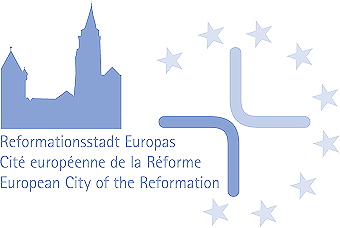The Great Church of Emden
In the ninth century, at the confluence of the rivers Aa and Ems just west of a new settlement later known as Emden, a special little mound was built that served as a Christian burial ground. It is possible that a wooden chapel stood there already then as well. The oldest part of the stone Great Church dates from the twelfth century, and the church underwent at least eleven stages of construction after that. Still visible is the Gothicstyle choir area, which was built between 1455 and 1509 and where, in a later period, the Reformed congregation celebrated the Lord’s Supper. The south aisle, which was designated as the burial place for the counts of East Frisia, was separated from the rest of the church by a sandstone wall that was designed by Cornelis Floris de Vriend from Antwerp in the Flemish renaissance style and completed in 1558.
The Great Church of Emden was destroyed during the Second World War in an Allied bombardment on December 11, 1943.
Like a Phoenix out of the Ashes ...
A new library built between 1992 and 1995 for the book collection of the Great Church was integrated into the ruins of the old church building. Thus the ecclesiastical library established in 1559 found accommodation in the very same location that the Reformed congregation had housed it since 1570. Today the collection comprises approximately 130,000 titles, among which are incunabula, over 6000 works from the sixteenth to the eighteenth centuries, and a section of 155 manuscripts. The library focuses on two areas: Reformed Protestantism and the confessional history of the early modern period. It also collects publications on East Frisian history and culture.
A major part of the old collection has been digitalized and is accessible via the Internet. In 1999, in cooperation with the World Alliance of Reformed Churches (now the World Communion of Reformed Churches), the library also created the website “Reformed Online”, which offers a variety of current information on the theology and history of Reformed Protestantism and serves as a communication platform for Reformed churches worldwide. The Johannes a Lasco Library supports scholarly research with conferences, lectures for a wide audience, and its own program of research. The magnificent space is also available for concerts and receptions and is often used for meetings of representatives from ecclesiastical, political, social, and cultural organizations. In addition, the building serves as a forum for art and culture through various exhibitions, with an emphasis on such topics as early modern art, ecclesiastical art, the art of printing, and the graphic arts.
Exhibitions
In the permanent exhibition space on the north-east side of the church, book lovers’ showpieces from the library’s own collection are displayed on a rotating basis. Each exhibition is built around a theme, such as, for example, early printings of Ctematius’s Deux-Aes Bible of 1562 during the time that Emden was a refugee community; books from the estates of Erasmus of Rotterdam and Rudolph Agricola; and manuscripts from the Aduard Monastery.
Johannes a Lasco
Who is the library named after? In 1993 the name of the Polish nobleman Johannes a Lasco (1499-1560) was chosen in order to honor him as the reformer of East Frisia and as a scholar known throughout Europe. From 1542 to 1549 a Lasco served as the “superintendent” of the Protestant congregations in East Frisia, organizing the structure of these new congregations by establishing a church council and the Coetus as the regional deliberative body for the ministers. With the help of church discipline, he devoted himself to promoting a devout lifestyle among the members of the congregations.
In this way he hoped to strengthen their faith and, by order of Countess Anna, to bring about unity of doctrine in the entire county over which she ruled. This involved also the demarcation of other religious parties in Em- den, such as the sizeable group of those who remained Roman Catholic and the numerous Anabaptists, represented in Emden by Menno Simons. A Lasco also tried to reach an agreement with the Lutheran Protestants, in which he sought to bridge their differences on such controversial points as the real presence of Christ in the Lord’s Supper.
During the interim in Germany, a Lasco had to flee to London, where he set about to organize a Protestant congregation of refugees and subsequently influenced in a significant way the formation of Reformed congregations in the Netherlands. When Mary Tudor became queen of England in 1553, a Lasco and his London congregation were again forced to flee. After a long search along the North Sea and Baltic Sea, they finally found a home in Emden. A reminder of this experience is portrayed in the stone carving of the ship (church) of Christ above the Great Church’s deaconsdoor along the Kirchstraβe. Around the carving is the following inscription:
“God`s Church, persecuted and driven away, God has given her comfort here.”
Mother Church
The emigrants from London joined the German congregation, whereas Walloon refugees in Emden founded their own french speaking congregation. All of them brought along their personal contracts and economic relationships to Emden, which was always a safe haven for those being persecuted in the Netherlands. Especially during the years 1568-1648, the period of the Dutch revolt against Spanish rule, Emden became a refuge, and the Reformed community there offered spiritual and churchpolitical support to persecuted congregations abroad. Thus the Great Church of Emden got the honorary title of “mother church” of the Reformed churches in the Netherlands. After 1595, when the tide of war had turned in favor of the resistors, the Dutch States-General offered support to the magistrate of the city of Emden, which was able to disengage itself from the authority of the East Frisian counts (who were favorably disposed to Lutheranism) and thus maintain a certain degree of independence.
<


